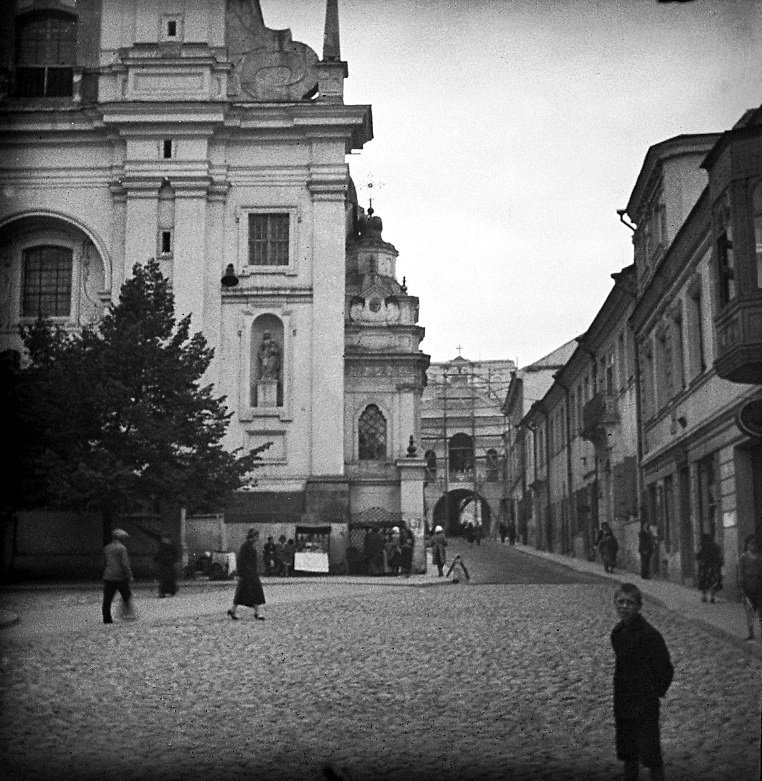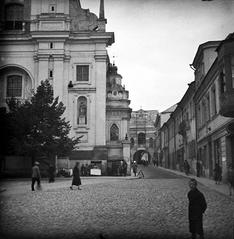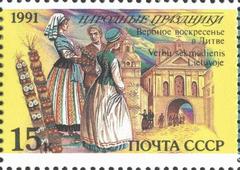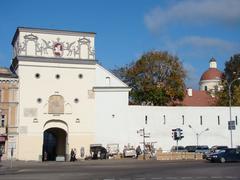
Gate of Dawn Visiting Hours, Tickets, and Historical Guide — Vilnius, Lithuania
Date: 14/06/2025
Introduction
The Gate of Dawn (Lithuanian: Aušros Vartai; Polish: Ostra Brama) stands as a symbol of Vilnius, renowned for its historical, cultural, and religious significance. Built between 1503 and 1522 as part of the city’s defensive walls, it is the only remaining gate from Vilnius’ original fortifications (History Hit; TravelO Lithuania). Over centuries, the Gate evolved from a military structure into a spiritual and national icon, largely due to the revered icon of the Blessed Virgin Mary, Mother of Mercy, housed in the chapel above the gate. Today, the Gate of Dawn is a prominent destination for pilgrims and travelers, offering a unique window into Lithuania’s vibrant history and living traditions (Catholic World Report; History Tools).
This guide provides an in-depth overview of the Gate of Dawn, including its historical background, religious and cultural importance, practical visitor information, accessibility, nearby attractions, ongoing preservation efforts, and essential travel tips.
Table of Contents
- Historical Overview
- Visiting Information
- Preservation and Restoration
- Practical Tips and Etiquette
- Frequently Asked Questions
- Conclusion and Recommendations
- References
Historical Overview
Origins and Construction (1503–1522)
The Gate of Dawn was constructed as a vital component of Vilnius’ medieval defenses, situated at a strategic entry point on the road to Medininkai. Originally called the Medininkai Gate, it was later known as Ostra Brama, or the “Sharp Gate,” marking the southernmost point of the city walls (TravelO Lithuania; Wikipedia). At its peak, the city fortifications included nine gates, but the Gate of Dawn alone survived the destruction of Vilnius’ walls in 1799, attributed to the presence of the sacred icon (History Hit).
Architectural Evolution
Initially built in the Gothic style, the Gate of Dawn underwent significant modifications reflecting Renaissance and Baroque influences (Evendo). The chapel, added in the 17th century, exhibits late classical features and houses the famous icon. Renovations in the 20th and 21st centuries have preserved its structural integrity and historical character (Vilnius.com.ua).
The Icon of the Virgin Mary and Religious Significance
The 17th-century icon of the Blessed Virgin Mary, Mother of Mercy, is central to the site’s fame. Painted in Renaissance style, the icon is associated with numerous reported miracles and has become a symbol of mercy and protection for Vilnius and Lithuania (TravelO Lithuania; History Hit). The chapel above the gate, built to house the icon, remains an active pilgrimage site, especially during the annual November feast and on Marian feast days (Catholic World Report).
Legends, Miracles, and Cultural Impact
The Gate of Dawn’s reputation for miracles is rooted in stories such as the 1702 Swedish siege, when the icon was credited with saving the city. A bullet hole from this event is still visible (Catholic World Report). The gate’s image appears in literature and art, notably in Adam Mickiewicz’s “Pan Tadeusz,” symbolizing hope and resilience (Vilnius.com.ua).
Survival Through Conflict and Political Change
Throughout wars, occupations, and political upheavals—from the Russian demolition of city walls to 20th-century struggles for independence—the Gate of Dawn endured as a beacon for the faithful and a symbol of national unity (History Tools). Its survival is attributed both to its religious status and the devotion of Vilnius’ people.
A Symbol of Unity and Multicultural Heritage
The Gate of Dawn is venerated by Lithuanian Catholics, Polish communities, Orthodox Christians, and others, embodying Vilnius’ multicultural legacy (Vilnius.com.ua). It unites diverse traditions and stands as an emblem of tolerance and shared cultural identity.
Visiting Information
Visiting Hours and Access
- May–October: 6:00 AM – 7:00 PM
- November–April: 7:00 AM – 7:00 PM
(Go Vilnius; Live the World)
Hours may vary for holidays or special events. Early morning visits offer a quieter experience.
Tickets and Entrance Fees
- Entrance: Free of charge for both the gate and the chapel.
- Donations: Encouraged for maintenance and preservation.
Accessibility
- Chapel Access: Upstairs via 35 steps; no elevator.
- Mobility: The exterior is accessible, but cobblestone streets may be challenging.
- Assistance: Contact local tourism offices for support.
Guided Tours and Special Events
- Guided Tours: Available via local agencies and tourist centers, often as part of Vilnius Old Town tours (The Road Trip Expert).
- Special Events: Notably, the Feast of Our Lady Gate of Dawn (November 10–16) features processions, Masses, and music (Our Lady of Šiluva).
Nearby Attractions
- Orthodox Church of the Holy Spirit
- St. Anne’s Church
- Vilnius Cathedral
- Gediminas Castle Tower
- Bernardine Gardens
All are within walking distance, allowing for a comprehensive Old Town experience (skyticket).
Facilities and Amenities
- Restrooms: Available in nearby cafes and restaurants.
- Shops: Souvenir and religious goods shops are close by.
- ATMs and Info Centers: Easily found in Vilnius Old Town.
Preservation and Restoration
Overview of Preservation Efforts
The Gate of Dawn has been the focus of preservation since the 19th century, with major work after Lithuania’s independence and its inclusion in the UNESCO World Heritage list (Vilnius Tourism; UNESCO World Heritage Centre).
Recent Projects and Community Involvement
- Structural stabilization (1993–1998): Repairs to masonry and fortifications.
- Chapel restoration (2005–2007): Roof and façade improvements.
- Icon conservation (2017): Non-invasive cleaning and analysis.
- Accessibility upgrades: Ramps and visitor flow management.
Ongoing maintenance is supported by local volunteers and the Catholic Church, with annual fundraising and municipal oversight (Vilnius Pilgrimage Center).
Challenges and Future Plans
Urban development, environmental stress, and tourism require constant management. Plans include digital documentation, eco-friendly initiatives, and enhanced visitor education (Vilnius City Council; Creative Europe).
Practical Tips and Visitor Etiquette
- Dress modestly: Cover shoulders and knees inside the chapel.
- Quiet behavior: Maintain silence during services.
- Photography: Allowed, but avoid flash and respect worshippers.
- Footwear: Wear comfortable shoes for cobblestone streets.
- Planning: Arrive early to avoid crowds and combine your visit with other Old Town attractions.
Frequently Asked Questions (FAQ)
Q: What are the visiting hours?
A: Typically, 6:00/7:00 AM to 7:00 PM, depending on the season. Check official sources for updates.
Q: Is there an entrance fee?
A: No, admission is free.
Q: Are guided tours available?
A: Yes, through local agencies and tourist information centers.
Q: Is the chapel accessible for people with disabilities?
A: The chapel is reached by stairs; the exterior is accessible.
Q: Can I take photographs inside?
A: Yes, but avoid flash and respect religious services.
Conclusion and Recommendations
The Gate of Dawn is a living monument of faith, history, and culture—offering free daily access, a welcoming atmosphere for all visitors, and a central location in Vilnius’ Old Town. Preservation efforts continue to balance tourism and heritage protection, ensuring this treasured landmark endures for generations (Vilnius Tourism; UNESCO World Heritage Centre).
For a deeper experience, plan your visit during feast days or consider joining a guided tour. Download the Audiala app for up-to-date information and audio guides, and explore related articles on Vilnius’s historical attractions.
References
- History Hit
- TravelO Lithuania
- Wikipedia
- Evendo
- Vilnius.com.ua
- History Tools
- Catholic World Report
- Our Lady of Šiluva
- Go Vilnius
- Live the World
- The Catholic Travel Guide
- skyticket
- The Road Trip Expert
- Vilnius Tourism
- UNESCO World Heritage Centre































































































